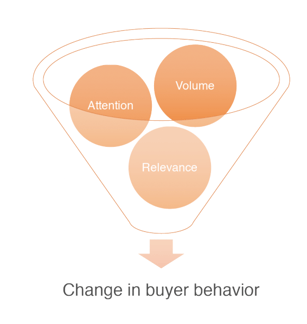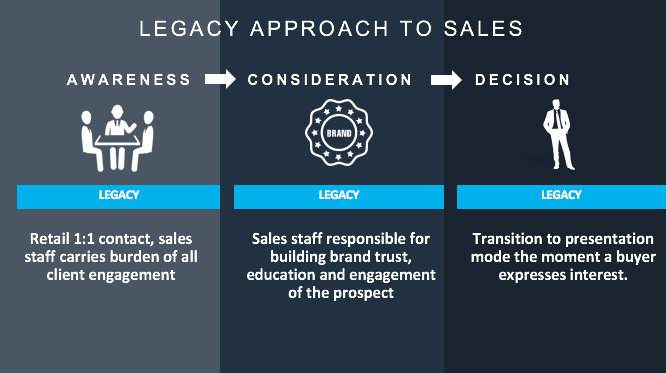B2B Purchase Decisions In Cleantech And The Digital-Social Criticality Scale
Across clean economy sectors, the sales and marketing teams we talk to share a growing frustration: it’s gotten harder to get renewable energy customer prospects to engage during the marketing process. They’re all too familiar with sending that seventh “touch base” email to a prospect they’ve connected with at the trade show and hearing nothing back. This experience has three main sources: what we’re calling the “VAR Phenomenon” (Volume, Attention, Relevance), and it's increasingly becoming a challenge in the smartphone age.
Volume
Your customers are exposed to an enormous volume of electronic content – which grows by 50 percent each year. Americans now spend roughly 10 hours a day in front of computers, smartphones, tablets and other devices.
Attention
The sheer weight of all that content has drastically shortened attention spans by at least 20 percent since the mobile revolution. According to a study by Microsoft, people now have an eight-second attention span, less than a goldfish, which can manage to focus on something for roughly nine seconds. We should note that some have criticized the study, but we think the main point stands: Americans have shorter attention spans.
Relevance
Shrinking attention spans mean that to attract a sales prospect’s attention, content must be relevant to their needs at the moment they recognize they have that need. The fact that someone searched for and selected your story or website is a strong indicator of relevance.

The Impact of VAR On Cleantech Customer Buying Behavior
The VAR Phenomenon has enormously changed how people buy things. Naturally, the approach to marketing clean energy products has been impacted as well. Specifically:
1. Buyers expect to find answers to all their questions online and at their fingertips – including how to buy your services/products when they’re ready to purchase.
2. Buyers want to be educated and informed before they talk to your sales team. They want to do their initial research on their own time.
Look at your own experience: When you decide to buy anything over $100, what’s the first thing you’ll do? You’ll Google it (or ask Siri). And then you search through the reviews.
How Americans buy things has fundamentally changed, extending all the way to purchase decisions for a commercial solar project or contract to service a wind farm.
Legacy Vs Modern Sales Methods In Cleantech
Every cleantech company we know has ambitious growth goals and limits on their marketing budgets. Regardless of how many resources you’ve got to work with, a buyer still needs to know these three things before purchasing from you:
a) Your company exists.
b) It solves the problems buyers think they have.
c) Your company is a trusted advisor with a proven ability to meet their needs.
Establishing a, b and c is essential; they are key elements to the essence of renewable energy marketing communications.
Our research to date shows that cleantech companies have historically under invested in marketing communications.
79% of business buyers say it’s absolutely critical or very important to interact with a salesperson who is a trusted advisor — not just a sales rep — who adds value to their business. Customers demand smarter sales experiences, and they want sales reps who are personal consultants that help them address their challenges instead of treating them like another lead in the pipe.
The Modern Renewable Energy Market

Changes in today’s marketing communications landscape create an opportunity for companies to use digital tools and compelling content to meet customers where they are. It allows companies to integrate marketing and sales in a highly effective combination. Marketing teams draw from the sales team’s insights into customers’ preferences and needs. Marketers then convert those insights into content that builds the early part of the sales process – creating awareness, producing more educated buyers, and qualifying prospects much more effectively.
This more updated approach frees sales staff to focus on later stages of the process, which only they can do effectively in high-ticket, long lead-time B2B industrial sales.
LEAD NURTURING
Sales teams in B2B or high-tech industries often have long sales cycles. Instead of sending that 3rd “just checking in” email, nurture your leads with informative, valuable content best delivered in digital platforms and URLs like blogs, videos, one-pagers, white papers, microsites, news articles, and webinars. Move to a customized email along the lines of “We believe this will be interesting to you because you mentioned __.” We call this “lead nurturing.”
B2B Content Creation for Cleantech Media
> Every minute, 300 hours of video gets added to YouTube.
> 350,000 tweets are sent per minute, 500 million tweets are sent per day.
> Every day, 2.5 million new blog posts are written.
To break through this flood of information, you must connect with buyers through compelling content that shows how you’re uniquely positioned to understand and solve their problems.
Regardless of its form – blog posts, white papers, taped conference presentations, surveys, and eBooks – great content talks to your customers about their needs, trends in their industry and leads them to a central entry-point in your company. Given how buyers purchase, the trail most likely leads next to your website (where they can find help). That’s where you can display competence and position your expertise by being useful to customers when they’re searching for solutions to their problems. Great content aimed towards prospective customers is rarely about your company – its culture, latest hire, or a significant new business win. As marketing agency trends expert, David Baker says: “No one is reading your newsletter.”
Four Principles of Cleantech Content Creation
Don’t just be interesting, be compelling
There’s a time when the client decides they need something. They go looking, and you – if you’ve taken our advice here – will be near the top of their search returns. Be sure your content educates in simple, skimmable, and brief formats.
Informing is about them and their problems; blathering is about you
Follow the 80/20 ratio for how much you should talk about customers (the 80 percent) versus yourself (the 20 percent)
Always. Be. Framing.
Build your company messaging around one positioning statement or framework that helps magnify your unique ability to solve customer challenges. Ensure that messaging is in plain language, it speaks to customers’ values, needs, and self-interests. It should minimize industry jargon and acronyms. Use your messaging to frame every piece of content.
Use news media for validation
There’s still a vital role for media coverage, also known as “earned media,” because it’s coverage you’ve earned by being interesting to a media outlet’s reporters and readers. But this coverage has a different role in cleantech media now. News coverage by itself generates limited customer or investor interest because of the sheer volume of content available to them. At the same time, media coverage can be a good validator for a company with a website that shares, explains, and amplifies that coverage. Be sure you use your website accordingly.
Inbound Marketing: Modern Cleantech Marketing Approach
The term “inbound” is used to describe a call center where customers called to get help or seek information. Digital marketers adopted the term to describe marketing efforts designed to draw buyers in(bound) to contact sellers, instead of sellers pushing their messages out(bound) to the buyer.
Outbound marketing relies heavily on tactics that interrupt what a person is doing – getting someone to stop at a booth while walking through a trade show or advertising to someone watching a video on YouTube – to deliver a message. Outbound marketing still has its place, but it’s a smaller role in the face of increased buyer resistance to being interrupted in the first place.
For cleantech companies marketing to hundreds or a few thousand people, digital inbound tools can inform and improve sales team efforts in a uniquely powerful way. Advanced Customer Relationship Management programs (CRMs), such as HubSpot (Disclaimer: we’re a partner) can flag sales teams when a customer is active on your company’s website, including which content was viewed and when.
Taking an inbound approach breaks the buyer’s journey into four phases:
1. Attract,
2. Convert,
3. Close, and
4. Foster loyalty
It’s important to generate content that speaks to the buyer’s experience at each of these stages.
Mapping Content to the Buyer’s Journey

Attract – The Awareness Phase
Potential buyers are beginning to understand they might have a problem to solve, and they start researching to learn more. That research kicks off online, and your company’s placement in search terms is crucial to getting picked as part of the list of vendors your buyer will select.
Content match:
Search engines, social media (read volume I of the Market Better series by Tigercomm, Social Wind: Social Media for the Wind Industry), earned media, third-party sites (professional organizations, directories, associations), analyst reports, and speaking events.
Convert – The Consideration Phase
Prospects know their problem, and they feel some urgency to solve it. They are considering options from an initial list of vendors. Your company begins to make the case for your solution, but not (yet) selling your company as the one to provide it.
Content match:
Expert guides, video, whitepapers, competitor sheets, product brochures, one-pagers, and e-books. Put this content behind a form requiring visitors to give you basic contact information before accessing “Convert Phase” content (ensure it is mobile-friendly). With the right website software, collecting this information allows your company to track future visits and to time follow-up sales contact.
Close - The Decision Phase
Buyers have settled on the best solution, and they are now choosing the vendor to provide it. They are comparing value and budget.
Content match:
Quotes, trials, demos, case studies and customized proposals and presentations that address their specific needs.
Loyalty – The Value Building Phase
Prospects have become customers, and they are now best positioned to make referrals to others. Your company’s job is to ensure they have a positive customer experience, so they become loyal brand advocates.
Content match:
Collect customer feedback, surveys, testimonials, case studies, and referral incentives. Consider video testimonials and case studies. Add value to their experience through exclusive offers or knowledge sharing.
Cleantech Digital Marketing Checklist
Using this checklist will guide your company to a better, more aligned marketing program that generates more qualified leads and greater business success in today’s attention-challenged digital marketing fishbowl.